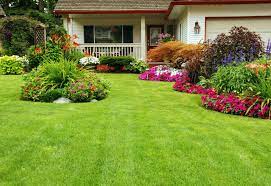Maintaining a lush green yard throughout the year requires proper care and attention. Each season brings its own challenges and opportunities for nurturing your lawn. By following these seasonal lawn care tips, you can ensure that your yard remains healthy and vibrant in every season.
Spring Lawn Care Tips
Fertilization
Spring is the ideal time to fertilize your lawn as it helps replenish nutrients lost during the winter months. Choose a high-quality fertilizer with the right balance of nitrogen, phosphorus, and potassium to promote healthy growth. Apply the fertilizer evenly across your lawn, following the manufacturer’s instructions.
Weed Control
Spring is also the season when weeds start to emerge. To prevent them from taking over your lawn, consider applying a pre-emergent herbicide. This will help prevent weed seeds from germinating. For existing weeds, use a post-emergent herbicide or manually remove them by hand.
Aeration
Aerating your lawn in the spring allows air, water, and nutrients to penetrate the soil more effectively. Use a core aerator to remove plugs of soil from your lawn, promoting better root growth and reducing soil compaction.
Summer Lawn Care Tips
Proper Watering
Proper watering is essential during the hot summer months. Water your lawn deeply and infrequently to encourage deep root growth. Early morning is the best time to water your lawn as it allows the water to penetrate the soil before evaporation occurs.
Mowing Techniques
Adjust your mower blade to the appropriate height for summer mowing. Taller grass provides shade for the soil, reducing moisture loss and preventing weed growth. Avoid cutting more than one-third of the grass height at a time to prevent stress on the lawn.
Pest Control
Summer is prime time for pests such as grubs, chinch bugs, and armyworms. Keep an eye out for signs of pest damage, such as brown patches or wilting grass. Consider using environmentally friendly pest control methods or consult a professional if the infestation is severe.
Fall Lawn Care Tips
Raking Leaves
Keep your lawn free of leaves and debris during the fall months. Piles of leaves can smother the grass and provide a breeding ground for pests and diseases. Use a rake or leaf blower to remove leaves regularly.
Overseeding
Fall is the perfect time to overseed your lawn to fill in bare patches and promote thick, lush growth. Choose a high-quality grass seed blend that is suitable for your climate and soil type. Spread the seed evenly across your lawn and water thoroughly.
Winterizing
Prepare your lawn for the winter months by giving it a final mow and removing any debris. Apply a winterizing fertilizer to provide essential nutrients for root development during the dormant season. Consider aerating your lawn again to ensure proper soil oxygenation.
Year-Round Maintenance
Soil Testing
Regular soil testing is essential for maintaining a healthy lawn. Test your soil at least once a year to determine its pH level and nutrient content. Adjust your fertilization and watering practices based on the results of the soil test.
Regular Inspections
Take the time to inspect your lawn regularly for signs of pests, diseases, or nutrient deficiencies. Address any issues promptly to prevent them from spreading and causing further damage to your lawn.
Professional Services
Consider hiring a professional lawn care service for routine maintenance tasks such as fertilization, weed control, and pest management. A professional can provide expert advice and customized treatment plans to keep your lawn looking its best.
Conclusion
By following these seasonal lawn care tips and incorporating year-round maintenance practices, you can achieve a lush green yard that enhances the beauty of your home. Remember to tailor your lawn care routine to the specific needs of your lawn and climate for optimal results.
FAQs
- How often should I fertilize my lawn?
- It depends on factors such as soil type and grass species, but generally, once in the spring and once in the fall is sufficient.
- Is it necessary to aerate my lawn every year?
- It’s not always necessary, but aerating annually can help improve soil quality and promote healthier grass growth, especially in compacted soil.
- Can I water my lawn too much in the summer?
- Yes, overwatering can lead to issues such as root rot and fungal diseases. Water deeply and infrequently, allowing the soil to dry out between watering sessions.
- How can I tell if my lawn has a pest infestation?
- Look for signs such as brown patches, wilting grass, and evidence of chewing or tunneling insects. Consult a professional if you suspect a pest problem.
- What should I do if my lawn has bare patches?
- Overseed the bare patches in the fall with a suitable grass seed blend and provide adequate water and nutrients for germination and growth.

